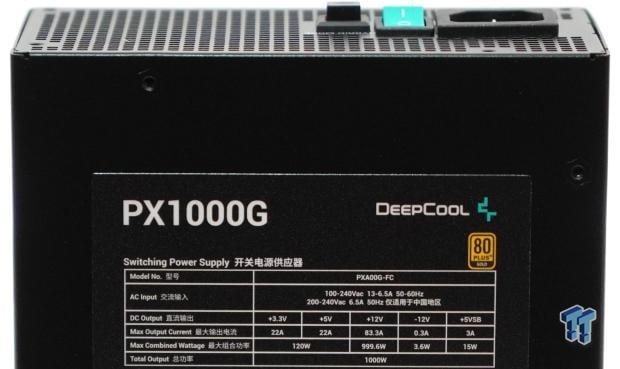
The Bottom Line
Pros
- + Ten-year warranty
- + 100% Japanese capacitors
- + Full 600-watt 16-pin 12VHPWR connection
- + Great build quality
- + Hybrid fan mode
Cons
- - Pricing is high compared to its competition
Should you buy it?
AvoidConsiderShortlistBuyIntroduction, Specifications, and Pricing
DeepCool recently announced the PXG line of ATX 3.0 PSUs, and we have the PX1000G here to look at; many thanks to DeepCool for providing the review sample. DeepCool has priced the PX1000G at around $200; this 1000-watt black brick might be worth its weight in gold with its full 600-watt 12VHPWR cable, 100% Japanese capacitors, and a literal decade with warranty. Let's dive into the deep...cool.

Packaging
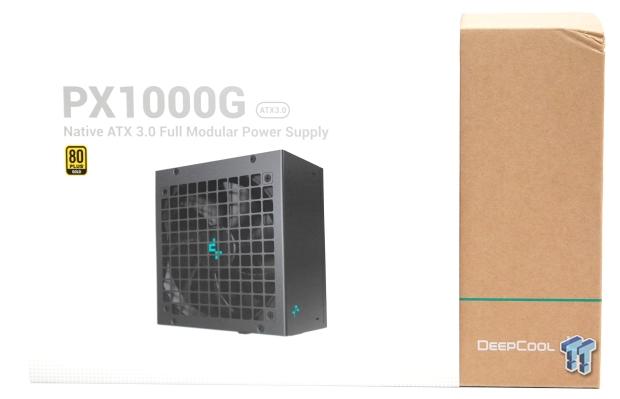
The PX1000G comes in a brown cardboard box with a white sleeve with a picture of the PX1000G on it. Also visible is the 80 Plus Gold rating.
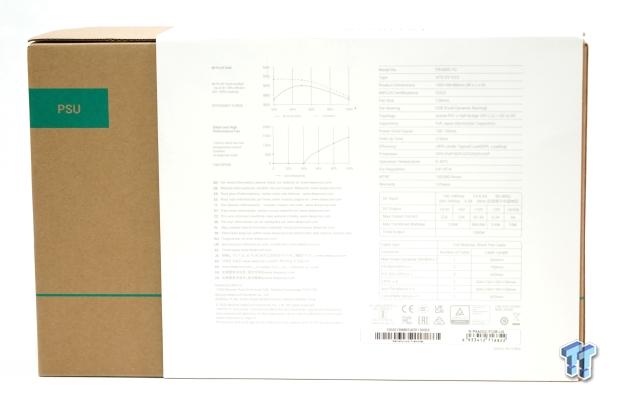
The back of the white sleeve shows various information about the PX1000G ATX 3.0 PSU. Efficiency curve, fan speed profile, and the typical PSU information you would normally find.
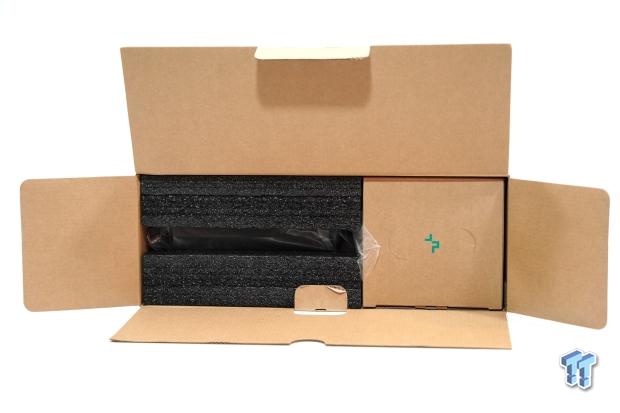
Opening up the brown cardboard box by the top flap, greeting us is the PSU in black foam and a smaller box containing all the cabling and accessories.

The smaller box with the cabling and the accessories is understated with a single blue-green line.
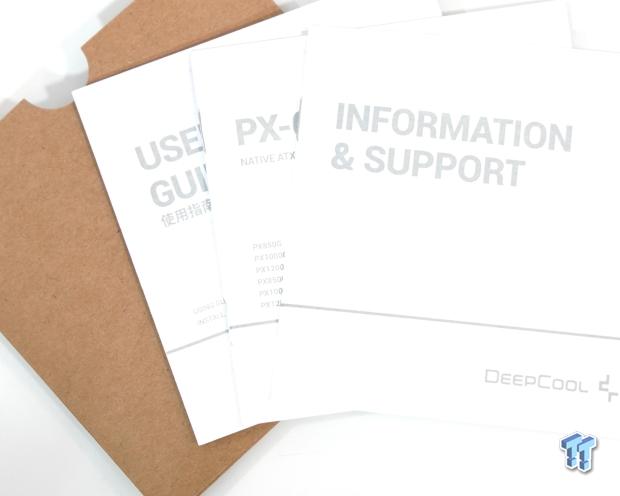
Inside the smaller box is the informational pamphlet with the user guide, warranty information, and specifications.
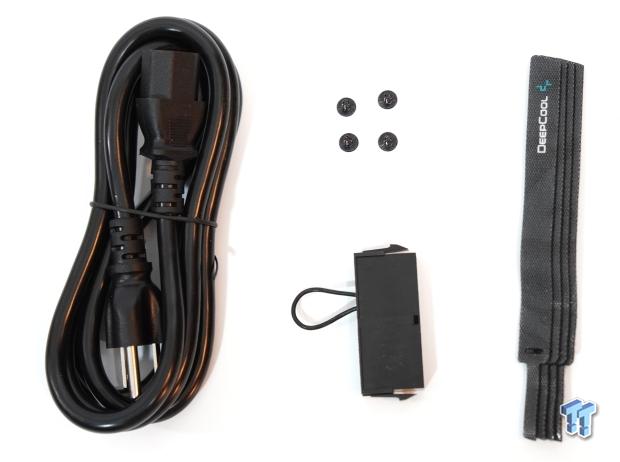
Going further in the smaller box are the accessories included with the PX1000G. In the packaging, a typical PSU power cable, four screws, DeepCool branded velcro cable ties, and lastly, a dummy PSU tester, which is not something you would normally find in a PSU box. Using a dummy PSU tester is helpful when doing things like water cooling when you only want to power the pump and not the rest of the system.
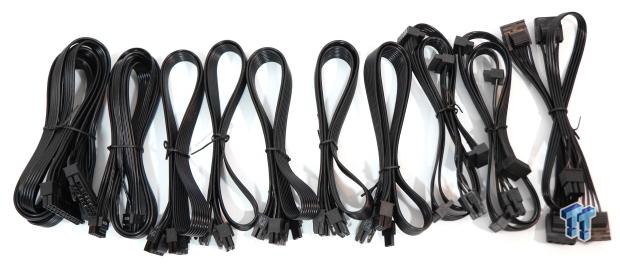
Lastly, all the cables that the PX1000G had included. All the cables are flat black ribbon style with no sleeving. Included are a Main Power 24-Pin cable, two 4+4-Pin EPS CPU cables, three 6+2-Pin PCIe cables, two SATAx4 cables, a single 600w 12VHPWR cable, and a four-plug MOLEX cable.
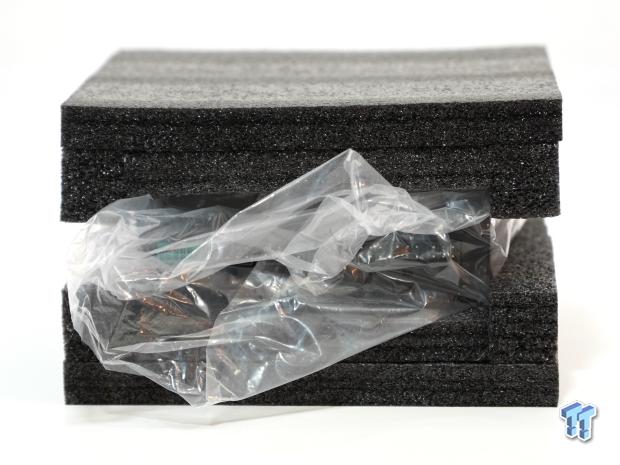
The PX1000G came sandwiched between two black pieces of dense foam with the PX1000G itself in a clear plastic bag.
Outside the DeepCool PX1000G ATX 3.0 PSU
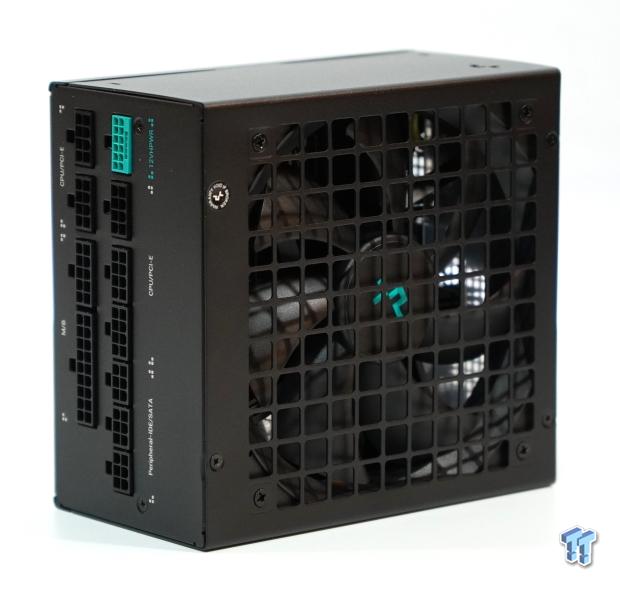
Removing the PX1000G from the packaging, the fan grille is the most noticeable, with a square ventilation pattern. The dimensions of the PX1000G are 150x160x86mm.
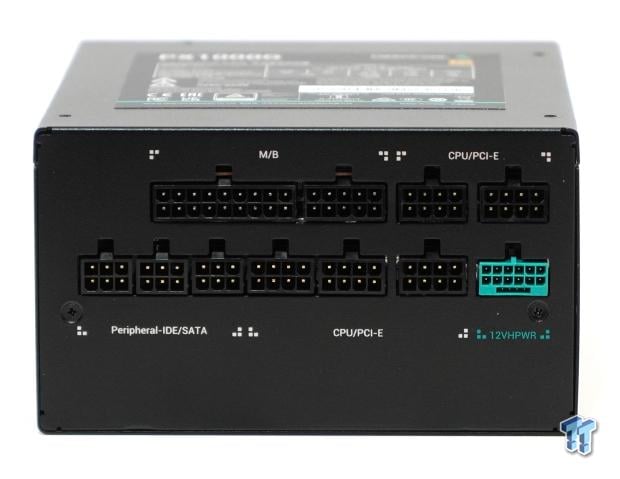
The cable input side of the PX1000G shows all the connections. The Motherboard 24-Pin cable input is split into an 18+10-Pin configuration. Next, cable input can be for the CPU or PCIe cables; the same goes for the lower inputs as labeled. The Peripheral/SATA connections work like the CPU/PCIe. The 12VHPWR connection sticks out here with a teal green color, helping users see if they have plugged the cable in, reducing potential issues with user error.
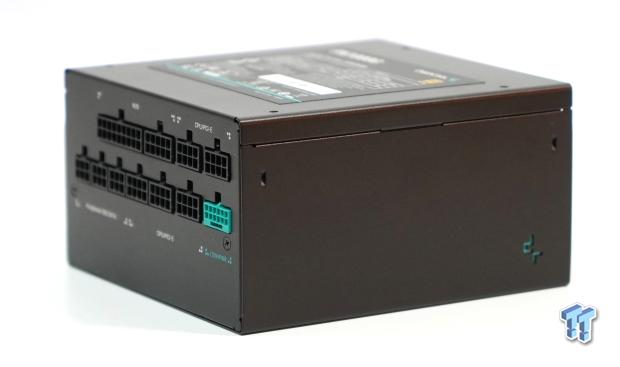
This side of the PX1000G is plain other than the DeepCool logo on the lower right-hand side.
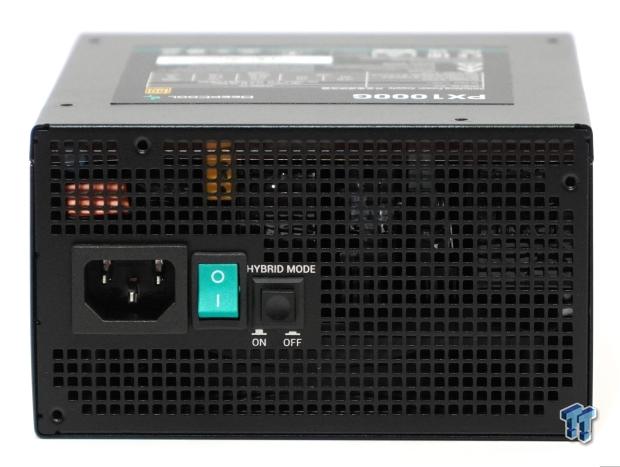
The rear of the PX1000G has the power input, a teal green power rocker switch, and a Hybrid Mode button. The hybrid mode on the PX1000G allows the internal 135mm fan to not spin until a certain temperature threshold. The rear of the PX1000G also has a square ventilation pattern, this time much smaller than the fan grille has.
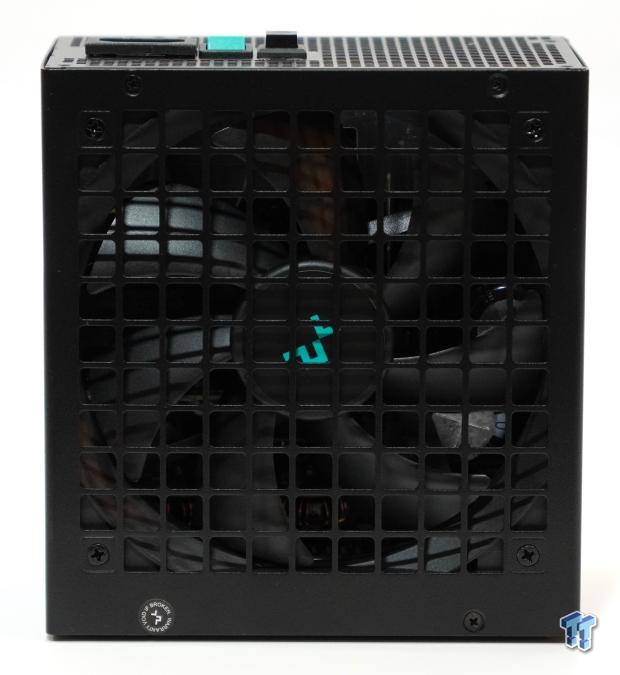
The fan measures 135mm and is a fluid dynamic bearing fan. Again the DeepCool logo is stickered and centered on the fan hub.
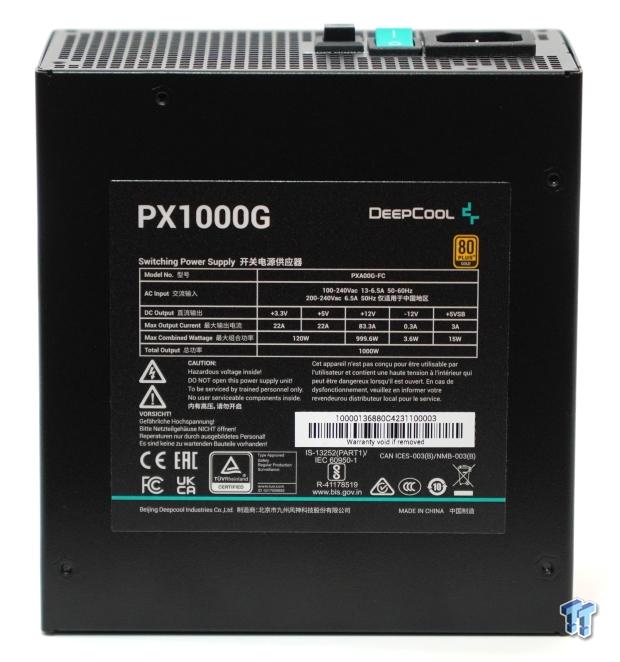
This side shows the same information on the external white sleeve. A single +12V rail with 83.5 amps, while the +3.3V and +5V each run with 22 amps of current.
Inside the DeepCool PX1000G ATX 3.0 PSU
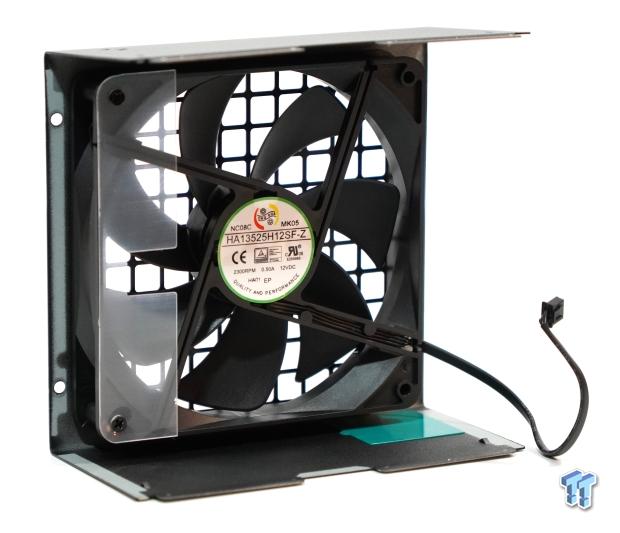
Opening the PX1000G reveals the 135mm fluid dynamic bearing fan mentioned earlier. This fan was sourced from Ong Hua, model number HA13524H12SF-Z, running up to 2300 RPM on a .5 amp.
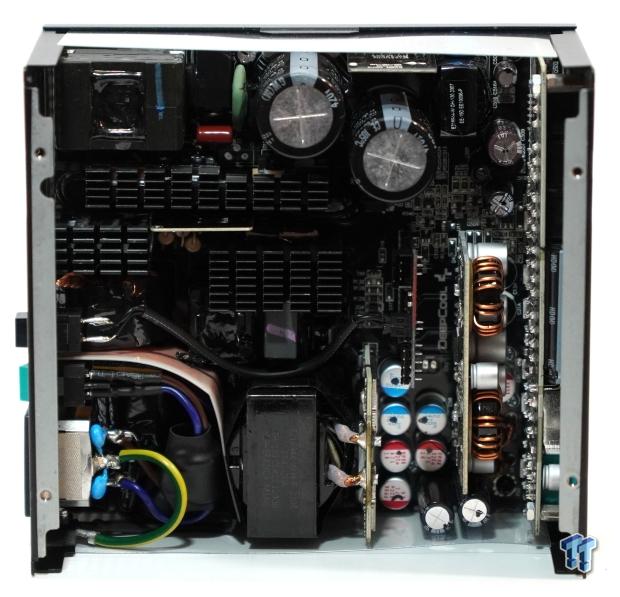
Just under 135mm fan shows the topology of the PX1000G, which is running an Active PFC + Half Bridge SRC LLC + DC to DC. The OEM for this particular platform is from CWT.
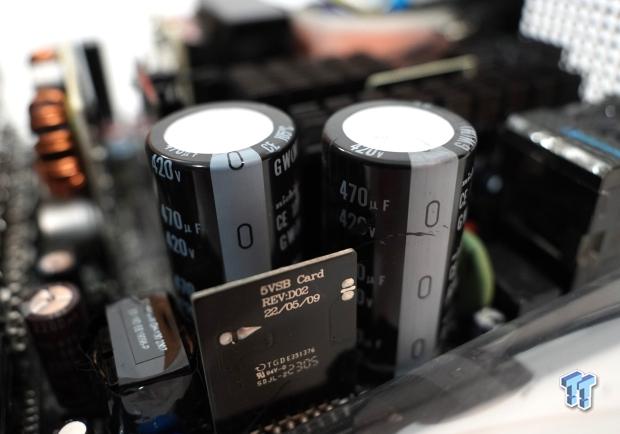
Two Japanese capacitors are rated for 470µF at 420V each, alongside the 5VSB card.
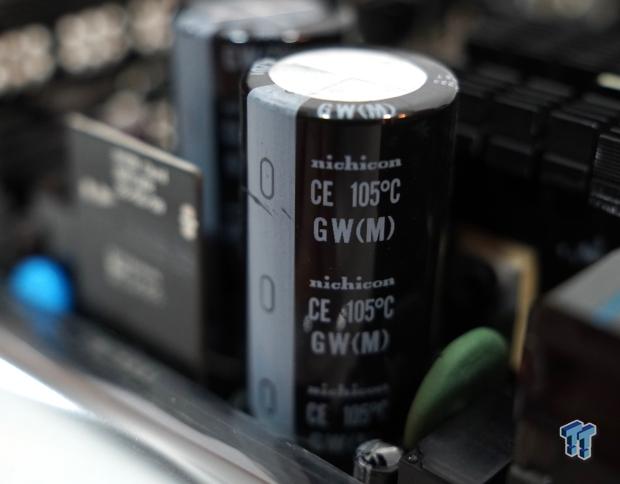
Nichicon, a Japanese capacitor corporation, is very widely known for its high-quality capacitors; these inside the PX1000G are rated up to an operating temperature of 105C.
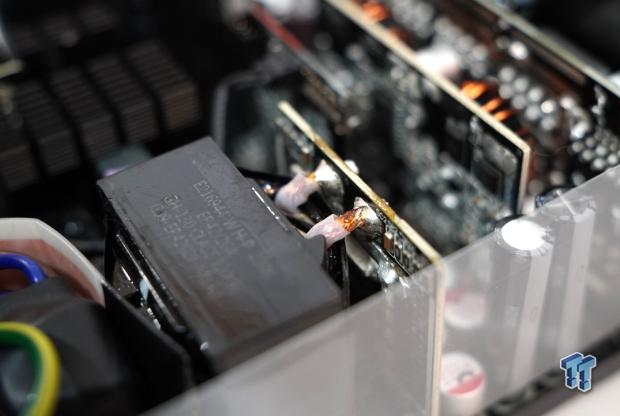
The main transformer and several daughterboards change the incoming AC voltage to the outgoing DC voltage levels.
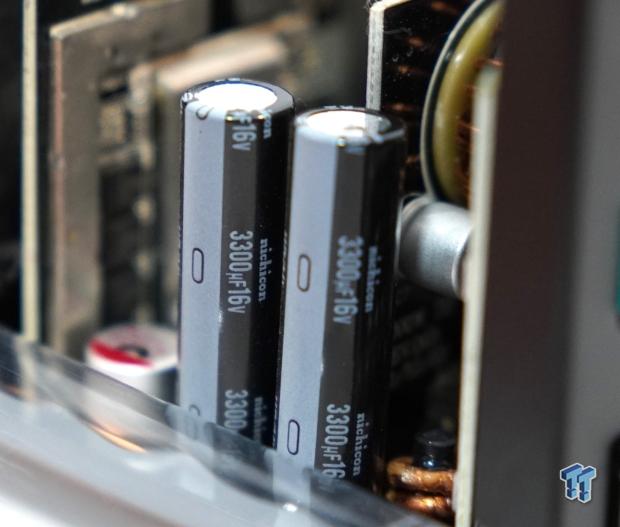
More Nichicon capacitors, this time a bit thinner, are rated for 3300µF at 16V each, again are good for up to 105C in operating temperature.
Test System
- Motherboard: B650 AORUS Elite AX (AMD B650) - Buy from Amazon
- CPU: AMD Ryzen 9 7950X - Buy from Amazon
- Cooler: Arctic Freezer II 360mm AIO - Buy from Amazon
- Memory: Corsair Dominator Platinum DDR5-7200 32GB - Buy from Amazon
- Graphics Card: NVIDIA RTX 3090 Founders Edition - Buy from Amazon
- Storage: Corsair MP600 PRO XT Gen4 PCIe x4 NVMe M.2 SSD - Buy from Amazon
- Case: Cougar DuoFace Pro RGB - Buy from Amazon
- Software: AIDA64 Engineer 6.32.5600, and CPU-z 1.94.0 x64
- Power Supply: DeepCool PX1000G 1000w ATX 3.0 PSU - Buy from Amazon
- OS: Microsoft Windows 11 Pro 64-bit Build 22621 - Buy from Amazon
- Software: AIDA64 Engineer 6.8.6300, and CPU-z 2.03.0 x64
Testing & Final Thoughts
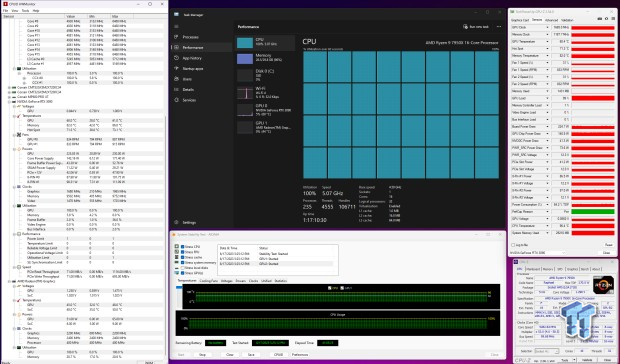
Testing the DeepCool PX1000G, I ran a typical load test via Aida 64 Engineer's System Stability Test for over 18 hours. The test pc has an AMD Ryzen 9 7950X 16 core 32 threaded AM5 CPU on a B650 AORUS Elite AX motherboard. The GPU is the NVIDIA RTX 3090 FE, which can pull around 350 watts without overclocking through the 12VHPWR power connection, which had to be power limited to 65%, resulting in only a power draw of 227 watts. The CPU drew an average of 166 watts, while the Ryzen 9 7950X's iGPU drew another 32 watts.
Pulling out my multimeter, I probed motherboard pins 24, the COM or ground pin, and pin 11, which is one of two +12V pins. Voltage readout was 12.13V while drawing 3 amps. Doing a wattage conversion makes for about 36 watts. The total is about 461 watts, while the Killawatt P3 reported 509 watts being pulled from the wall. The PX1000G did almost exactly what the 80 Plus Gold rating calls for, 90.5% efficiency at 50% load, spot on.
So, is the PX1000G from DeepCool the ATX 3.0 PSU you have been looking for? Possibly, but I know that the PX1000G performs exactly as intended. What you see is what you get, nothing more, nothing less. Having a 10-year warranty these days is few and far between. Most PSUs coming to market only have a 5-year warranty, which only lasts an upgrade cycle or two. With a 10-year warranty, that upgrade path is now doubled, building more value in spending more on a PSU, then buying another later when the cheaper PSU is out of warranty.
That said, there are a few other ATX 3.0 PSUs on the same CWT platform for a few bucks less than the PX1000G, and they carry the same 10-year warranty.

